Citroen
|
1919 - Present |
Country: |
 |
|
For many years, Citroen was rightly considered a pioneer in the refinement of front-wheel drive, the development of hydro-pneumatic, self-levelling suspension, research into more
aerodynamically efficient body shapes, the adoption of full power braking as a standard feature, swivelling directional headlights and the self-centring and variable-ratio
steering system (as fitted to the high-performance SM model).
But it was one model, rather than all the technical innovation, that played the most significant role in the rise to popularity of Citroen - the 2CV, or Deux Chevaux as it was affectionately known.
Four Wheels Under An Umbrella
Launched in 1948, the 2CV epitomised the hopes and aspirations of post-war Europe and, more particularly, a liberated Gallic conscience. In every sense it was truly a people's car. It was designed by Pierre Boulanger to the formula of 'four wheels under an umbrella, enabling a countryman to carry a basket of eggs without breaking one of them'.
Indeed, had it not been for the war's intervention, the 2CV could well have pipped Volkswagen to the title of 'People's car', as the Citroen was, in fact, conceived in 1936. For many decades after its release no one travelling the continent of Europe could have failed to have felt they were being shadowed by one of the ubiquitous Deux Chevaux, always visible in their rear-view mirror, buzzing along at a steady 60-65 mph.
And if it was not a 2CV, then it was probably a Dyane, an Ami or one of the other derivatives of Monsieur Boulanger's basic concept. Such had been the model's impact that it remained, with certain modifications, being made by Citroen factories throughout the world for decades after its release.
Back in 1915, however, such success would have been unthinkable. It was in that year that 37-year-old Andre Citroen decided to build, on 30 acres of vegetable gardens and waste land at Quai de Javel (later Quai Andre Citroen) in Paris, what was to become one of the most modern car producing factories in the world.
Chevron Toothed Gear Wheels
Two years earlier, and 12 years after graduating from the Ecole Poly technique, he had founded a company to exploit a patent for chevron-toothed gear-wheels which worked smoothly, silently and efficiently. Now he was ready to build motor cars; so what better maker's symbol to adopt than the double chevron. On 28 May 1919, the first car to bear his name left the assembly line. With this car, an open tourer called the Type A, Citroen immediately broke new ground. It was the first car to be mass produced in Europe and the first to be delivered complete with its hood, spare wheel and other such paraphernalia.
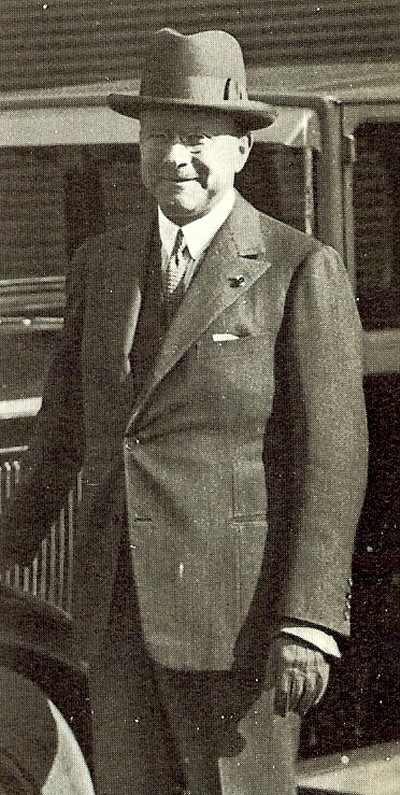
Andre Citroen.

1919 Citroen 10hp Type A.

1922 Citroen 5CV, which preceded the famous clover-leaf model.
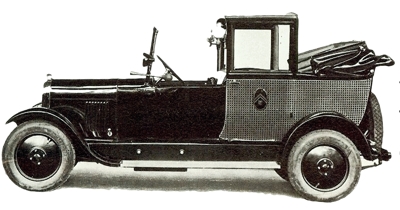
1926 Citroen B14 Landaulette Taxi.
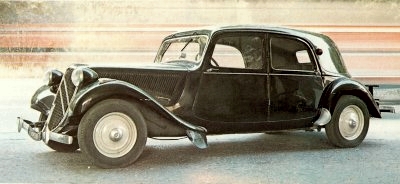
1934 Citroen 11AL, which was front-wheel-drive, and combined with the low, forward positioned centre of gravity it possessed roadholding unheard of in its day.
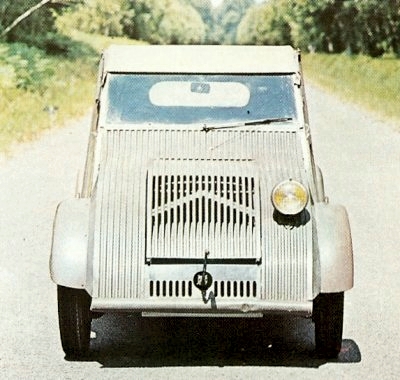
1939 Citroen 2CV. It was sparce and utalitarian, but was loved by the poorer French who could finally afford a motor car.

1955 Citroen DS19, this image clearly showing the air intakes under the front bumper.
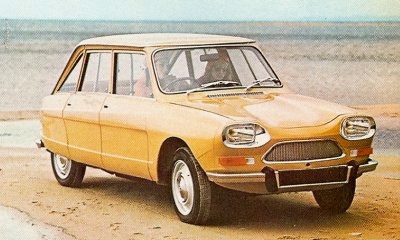
1969 Citroen Ami 8 - which was a further development of the 2CV.
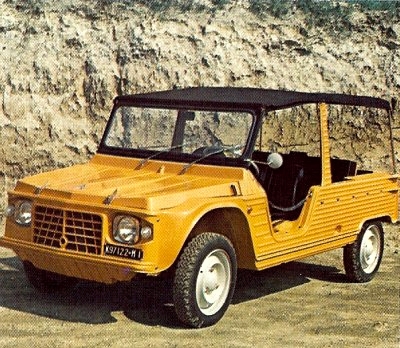
The 1969 Citroen Maheri, a front wheel drive farmers utility driven by a twin-cylinder 602cc engine developing 28 bhp.
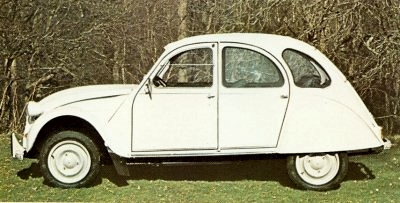
The 1970 Citroen 2CV 6.
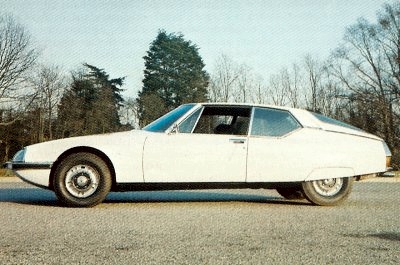 The Citroen SM in profile, powered by a 2.7 litre Maserati V6. The Citroen SM in profile, powered by a 2.7 litre Maserati V6.
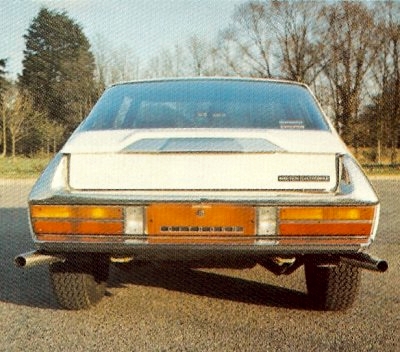
Rear view of the Citroen SM. Technically advanced, it featured a 5 speed gearbox, hydro-pneumatic anti-dive anti-squat self levelling suspension and variable ratio power steering.
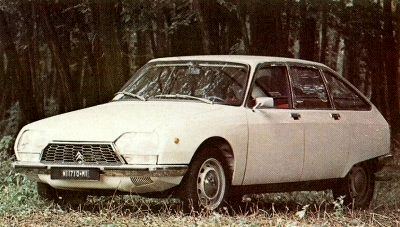
1971 Citroen GS, which took the Car of the Year award from the Range Rover, and the Citroen SM coming third place. The GS had a unique combination of bulbous yet angular styling and an aerodynamic yet roomy body.
|
Until then, all sub-assemblies had been manufactured by skilled craftsmen, and the finished 'chassis' ordered by customers who would then send them off to a reputable coachbuilding firm to be clothed in some suitable bodywork. With a price tag of 7250 francs, well below that of its competitors, the Type A was certainly designed to win over the populace. Andre Citroen stated that his aim was to build 100 cars a day-a desire immediately dismissed by the pundits of the time as wishful thinking.
By 1924, the Citroen works were producing nearly three times that figure, rising to 400 a day in 1928. The Type A, a four-cylinder car, had a top speed of 40 mph on level ground, a petrol consumption of 38 mpg and an oil consumption of three to four pints per 100 miles. According to engineers involved on the project, it was economical because it was light: its chassis weighed only 990lbs. The standard specification included an electric starter and electric lighting - both well ahead of their time - and there were five body styles to choose from: three-seat open-tourer, four-seat open-tourer, three-seat saloon, coupe-de-ville and light delivery van.
For Those Who Consider That A Motor Car Is An Asset
Citroen's advertising announced: 'For those who consider that a motor car is an asset in one's work as well as one's leisure'. Enthralle with the offer of such a car, ready for the road and complete with accessories, the public quickly responded. Within a fortnight 16,000 orders were received by the factory, without anyone having seen the car. '
Everyone is talking about the Citroen, but nobody knows it yet', wrote a leading French motoring magazine on 27 April 1919.
Critics of Citroen and his dreams had earlier prophesied that he might be able to build his cars but wouldn't be able to sell them. As it transpired, they choked on their words. He sold all 30,000 before building them! Fate played a helping hand at this time for, in June of that year, as the first Type A was delivered to a customer, the major rival, Renault, suffered a strike. In just four months, the Type A and its builder were the toasts of the Paris Motor Show at the Grand Palais.
However successful his products were in those early days, Andre Citroen was never slow to spot ingenious ways of gaining further publicity and prestige for his stable. At that motor show, he had 50 demonstration cars waiting to take prospective customers for a joy ride and, in the same year, organised factory visits for the general public. In 1920, Citroen renewed the entire fleet of Paris taxis in one sweeping operation. He built up a network of fast motor coaches in the Paris suburbs and, in a number of provincial towns, founded a red uced-rate insurance company for his customers.
A Pioneer In Aeroplane Advertising
Andre Citroen was also the first to use aeroplane advertising - with letters written in smoke - and, from 1925 to 1934, the company name shone from 250,000 electric light bulbs forming 100-foot-high letters round the Eiffel Tower. Right from the start, Citroen backed his car with an efficient after-sales service network which totalled 200 agents in 1919. Six years later, the numbers had swollen to 5000. Subsidiary companies had also been formed in Belgium, Switzerland, Spain, Germany, Sweden, Poland and, by 1923, in England.
A works was established at Hammersmith to serve the growing numbers of Citroen owners in and around London. Back at the factory, the Type A was joined in 1921 by a revised four-cylinder model designated the B2. This, in turn, was followed by a sports version, equipped with light-alloy pistons, called the Caddy. Credited as the first 'sports' car to be derived from a standard production model, the Caddy had a top speed of nearly 56 mph.
Touggourt To Timbuktu
In 1922, the B2 made history by becoming the first car to cross the Sahara Desert. Led by Georges-Marie Haardt and Louis Audouin-Dubreuil, the Citroen expedition travelled 2000 miles across roadless desert, from Touggourt, in Algeria, to Timbuktu, in 22 days. Based on production B2 models, the cars were fitted with rear tracks designed by Kegresse, a Russian engineer. In addition to carrying petrol, spares and food for the journey, each vehicle was equipped with a machine gun and rifles to ward off hostile tribesmen.
The Black Cruise
Two years later, an even more ambitious project began. Sixteen men in eight half-tracks, again based on the 9 hp B2, left North Africa on the famous 'Black Cruise'. Starting from Columb-Bechar, in Algeria, they crossed the Sahara, then proceeded through more than 5000 miles of pathless jungle in the Congo - navigating by compass - to Lake Victoria. There the expedition split, one party going via Cape Town, and two others through East Africa, to the final rendezvous in Madagascar.
While all this was happening, several new developments were emanating from the factory. The SCV two-seater came out in 1922 followed by a three-seat version - the now famous 'Clover Leaf' - a year later. The B2 design was further developed, the Bro appeared and then, in 1925, the B12, which featured a single-piece, all-steel Budd body and four-wheel brakes, was introduced. With this car, Citroen again achieved two 'firsts' in the field of mass-produced vehicles.
The B14, B15 and the first French Heavy Truck
A year later, the servo-braked B14 was launched, together with the B15s - the first French-made heavy truck with a closed driver's cab. During this period, a considerable expansion of production facilities took place in Paris. In 1921, the company rented a factory from Automobiles Clement- Bayard at Levallois and commenced production of the SCV Trefle there the following year. Another plant for the machining and assembling of SCV gearboxes was opened at Saint-Charles in 1923, coinciding with the inauguration, at the Javel works, of the first 160-foot- long conveyor producing 100 cars daily.
In 1924, a new factory at Saint-Quen began producing the B12'S steel body, and a spring-making facility opened at Epinettes. Two years later, a foundry and forge opened at Clichy, followed by an axle assembly plant at Grenelle. The same year also saw the opening of Citroen's first production units outside France - at Brussels Forest in Belgium, Cologne in Germany, Milan in Northern Italy and Slough in England. At the Montlhery circuit near Paris, the company broke numerous world records for non-stop driving with a series of cars affectionately named
Rosalie.
In 1932, the factory launched a new range-the 8, 10 and the 15 - with 'floating power' engines, and it was an 8A fitted with a special body that, in 1933, created a record that would stand for decades to come: 186,400 miles in 134 days at an average speed of 58 mph. Having proved the worth of his existing range, Andre Citroen once again turned his attention to the future, laying plans that would see his company successfully through the next two decades.
Michelin Assumes Control
Contemplating a daily output of 1000 cars while considering the introduction of his new
front wheel drive model, he decided, in 1933, to demolish the Javel works entirely and re-build them, all within a time schedule of five months. While this work was being carried out, Javel continued producing cars at a steady 360 units a day' For all his qualities, Andre Citroen also had his failings. His aggressive marketing policies did not always tally with his accountants' demands and, in 1934, he found himself in serious financial difficulties, so much that he could not meet his commitments. At the French government's request, Michelin, one of Citroeri's largest creditors, settled the outstanding accounts and took the car manufacturer in hand.
The new 'Traction Avant' model everyone had been waiting for appeared in 1934, taking the country by storm. A 7 hp model - subsequently 9 hp and 11 hp - with a 'floating power' four-cylinder, overhead-valve engine, its
front wheel drive layout endowed it with roadholding powers which, at that time, were considered astounding. Other technical innovations adopted in the 7CV for the first time in a mass-produced car included an integral underslung steel body with no running boards, flat floorboards, seats inboard of the side chassis members for protection against lateral shocks and torsion-bar suspension.
Weighing under 2000 lb, the car had a top speed of 75 mph and a fuel consumption of 32 mpg. The front-drive layout not only increased the space available inside the car but, in moving the centre of gravity forward, increased the front wheels' adherence to the road. A year after the 7CV'S introduction, Andre Citroen died, but the company - now in the safe hands of France's premier
tyre firm - moved into a new era of expansion. Development work on the 2CV began in 1936, a larger six-cylinder version of the 7CV called the 15-Six appeared in 1938 and, by May 1939, 250 prototypes of the 2CV were ready at the Levallois works for an autumn Paris Motor Show that never took place.
Instead, war came to Europe and Citroen production gradually came to a halt. Life returned to the Citroen factories when hostilities ceased and, in 1946, annual output reached 24,445 units. The first post-war design from the company was a 24 cwt van with a ribbed-member steel chassis, which arrived on the scene in 1947, while the long-awaited 2CV finally reached the showrooms a year later. Its unusual appearance, economical nature, incredible versatility and the cunning way it was laid out and equipped, astonished everyone at the Paris Motor Show. A 375 cc, flat-twin,
air-cooled engine pushed it along at 40 mph, whilst returning a fuel consumption of nearly 65 mpg. Technical innovations included longitudinal inter-acting suspension, independent axle arms, inertia dampers on all four wheels and distributorless ignition.
The Hydro-Pneumatic System
A lull in Citroen fortunes followed the 2CV'S introduction. Nothing new appeared until the Paris show of 1954, when a 425 cc 2CV, in AZ saloon and AZU light-van versions, with a centrifugal clutch now fitted as standard, was introduced. During those six years, however, the company's engineers had been busy perfecting a revolutionary new form of independent suspension - the hydro-pneumatic system - which, at the end of 1953, found its way on to the 15-Six. It was really intended for Citroen's new 11 hp saloon, the DS19, which again produced a sensation when it was launched at the 1955 Paris Motor Show.
Continuing with front-wheel drive, Citroen added their new self-levelling suspension, plus power assistance for clutch,
steering and front disc brakes-the first production-car manufacturer in the world to fit discs as standard equipment - and, an automatic braking-power distributor dependent on vehicle load. Its four-cylinder engine delivered 75 bhp and, with its highly streamlined body, concealed
radiator grille, under-chassis fairing and absence of window rims, it had a top speed of close on 90 mph. The car's record - along with that of its less luxurious sister model, the ID19 - spoke for itself: two outright victories in the Monte Carlo Rally, one in the Liege-Sofia-Liege, the Tour de Corse, the Finnish Hanki and Thousand Lakes and many many more.
The DS and ID models were very advanced in the 1950S, when they were introduced, but they were still ahead of their time in the early 1970S. Overshadowed by the DS/ID range, the famous 'Traction Avant' models finally disappeared from the production lines in 1957. After that, the Citroen range steadily increased with the introduction of the Ami 6 in 1961, a four-door, 602 cc flat-twin which was a further development of the 2CV. Other derivatives of the 2CV continued to come from the design shops of Citroen: the 2CV4 and 2CV6, 435 cc and 602 cc, respectively, rebodied versions of the older models; the Mehari, a rugged little utility vehicle which is custom built for the needs of the French farmers, and the Dyane series.
The Citroen M35 Wankel
Also, it didn't go unnoticed that, in 1969, a coupe Wankel version of the recently introduced Ami 8 was built. The car, designated the M35, had a 497 cc rotary engine that produced 49 bhp and gave the car a top speed of just on 90 mph. 500 of these cars were built and supplied to selected customers who, in turn, kept the company well informed about the behaviour and reliability of each model. The fruits of Citroen's endeavours were to be seen a few years later. Meanwhile, Citroen had purchased the Panhard company, in 1965, and the Berliet commercial vehicle factory in 1966 and, by 1968, had bought a controlling interest in Maserati.
An Object Design In Sheer Technical Brilliance
The company had also, against the wishes of President de Gaulle, been negotiating with Fiat, with the net result that Fiat acquired a 15% stake in Citroen. Out of all these mergers, controlling interests and outright purchases, the most significant proved, in 1970, to be the collaboration with Maserati. For it was in that year the
front wheel drive Cirroen-Maserati SM was introduced. An object design in sheer technical brilliance, the SM was immediately acclaimed as the most advanced car in the world. Underneath the sleek, highly aero-dynamically efficient body was a Maserati, 2.7-litre, four-overhead-cam, 90° V6 engine which drove through a Citroen-designed 5-speed gearbox and gave the car a top speed of 140 mph.
The SM also featured hydro-pneumatic, self-levelling, anti-squat, anti-dive suspension that had three ride-height settings depending on road type and surface, self-levelling, directional headlights (6 in all) and
steering with servo-assistance that decreased as the car's speed rose. The car was primarily available with Weber carburettors which were later replaced by Bosch fuel injection. An automatic version with a 3-Iitre engine was later to be made available in France.
Not content with stunning the world's motoring press with the SM, in November of the same year, Citroen announced the GS, a car which combined all the technical qualities of the DS in a compact body of almost mid-sized dimensions. One of the GS's minor failings, some thought, was that it was underpowered, although, enclosed in a body with a drag co-efficient of just 0.3, the 1015 cc, flat-four, overhead-cam,
air-cooled engine could still push the car to just over 90 mph. Perhaps due to public demand, a 1220 cc version was announced in 1972; this added a couple of mph in top speed and knocked about a second off the 0-60 mph time.
The Citroen GS Birotor
If anyone thought that Citroen were content to leave the GS with a 60 bhp flat-four engine, they were wrong. In 1973, a twin-rotor Wankel GS, with the equivalent of 1990 cc, was announced for production in 1974. With 107 bhp on tap and a top speed of 110 mph, the GS Birotor should have had an assured future but was discontinued little more than a year after its introduction. Another new Citroen, the Ami Super, was introduced in 1973 and had the GS 1015 cc engine mounted under its innocent-looking bonnet. It has given quite a fright to many people who associate the Ami with twin-cylinders and 600-odd ccs, This car was capable of 88 mph, and reached 60 mph in 16.5 seconds.
Meanwhile, the DS series had evolved into the DS 23 Injection Electronique, a 2.3-litre, fuel injected, 130 bhp version looking almost exactly the same, except for its twin-directional headlamp system, as the DS19 of almost 20 years before. The DS and SM were discontinued in 1975 and the beautiful CX range was introduced. In 1976 a link with Peugeot saw the introduction of the small LN, which used a Peugeot 104 body and Citroen mechanical components, principally the 602 cc flat-twin Ami 8 engine, Over the past few years, some people have criticised Citrocn for making cars that are too complicated and intricate. Whatever the case, Citroen still have customers queuing up to buy their wares whether for the domestic 2CV series or the luxurious CX and, as long as the customers come, Citroen will continue to set the technical standard by which others are judged.
Production of the 2CV Ends
Production of the versatile 2CV was ended in 1990. Companies like Chrysler with the CCV concept car, Toyota with the Scion xB and Honda with the Element had recognized the 2CV concept and translated it to the modern era. More recently, Citroën introduced the C3 Pluriel, an unusual convertible with strong allusions to the 2CV, both in body style (such as the bonnet) and in its all-round practicality. The Pluriel is but one example of Citroën's return to innovation, after launching somewhat dull (although efficient) models throughout the 1990s. Other examples are the C2, C4, and C6. The introduction of newer models, such as the long-awaited XM replacement, the C6, indicates Citroën's continued commitment to innovation in the 21st century. But the days of clean-sheet thinking and truly radical innovation are long gone. Being too avant-garde and too far ahead of public taste is too risky. In 2003, Citroën sold 1,372,500 cars, according to the PSA Peugeot Citroën group's 2003 annual report.
Also see: Citroen Car Reviews |
Citroen Colour Codes 


